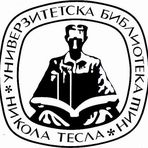Title
Analitički model za procenu dinamičke potrošnje aritmetičkih kola implementiranih na FPGA
Creator
Jovanović, Bojan 1981-
Copyright date
2012
Object Links
Select license
Autorstvo-Nekomercijalno-Bez prerade 3.0 Srbija (CC BY-NC-ND 3.0)
License description
Dozvoljavate samo preuzimanje i distribuciju dela, ako/dok se pravilno naznačava ime autora, bez ikakvih promena dela i bez prava komercijalnog korišćenja dela. Ova licenca je najstroža CC licenca. Osnovni opis Licence: http://creativecommons.org/licenses/by-nc-nd/3.0/rs/deed.sr_LATN. Sadržaj ugovora u celini: http://creativecommons.org/licenses/by-nc-nd/3.0/rs/legalcode.sr-Latn
Language
Serbian
Cobiss-ID
Theses Type
Doktorska disertacija
description
Datum odbrane: 21.02.2013.
Other responsibilities
mentor
Jevtić, Milun
član komisije
Litovski, Vančo
član komisije
Dokić, Branko
član komisije
Damnjanović, Milunka
član komisije
Petković, Predrag
Academic Expertise
Prirodno-matematičke nauke
Academic Title
-
University
Univerzitet u Nišu
Faculty
Elektronski fakultet
Group
Katedra za merenja
Publisher
[B. Jovanović]
Format
125 str.
description
Biografija [autora]: str. 125
Abstract (en)
During the past years the progress of silicon process technology marched on
relentlessly. According to Moore’s law, silicon process technology continues
improvement at an astonishing pace. Every 2 years the number of transistors that can
be integrated on a single IC approximately doubles. The continued scaling of the CMOS
technology has led us into the deep submicron regimes where design is not limited by
the functionality on a chip but is constrained with its power consumption. Numerous
portable battery-powered electronic devices with outstanding performances are the
prove of previous statement. Starting from 180nm technologies, static power
consumption due to leaky “off” transistors is now a non negligible source of power
dissipation, even in running mode. Thus, the total power consumption (i.e. dynamic plus
static power) has to be optimized instead of simply reducing dynamic power.
The first part of this work is oriented toward the problems of power consumption
(both static and dynamic) minimization techniques. The largest impact on power
reduction can be achieved at the system level where architecture and algorithms are to
be defined. Influencing power consumption without sacrificing system performances is
becoming harder and harder at the lower levels of system design flow. Selecting the
most power efficient algorithm out of many available requires a fast and accurate way
to estimate the power consumption of any implementation. In this way, time-consuming
low-level implementations of each possible design architecture will be avoided.
Therefore, the second part of this thesis deals with high-level dynamic power
estimation models of DSP-oriented (Digital Signal Processing) designs. This dissertation
is the continuation of the work on power estimation models described in [Jev09] and
presents the methodology for high-level logic power estimation which is based on the
component’s structure and the analytical computation of the switching activity
produced inside the component. Power estimation models are parametrized in terms of
input signal statistics (mean, variance, autocorrelation) and operands’ word-lengths.
The improvement of the existing model for ripple carry array multiplier switching
activity (dynamic power) estimation is firstly presented. Unlike previous DBT (Dual-Bit
Type) model, the TBT (Triple-Bit Type) model presented here takes into account nonlinearities
in bit-level switching activities occurring at the multiplier output. It is
experimentally confirmed that the model proposed in this thesis gives far better power
estimations (four to five times) than the previous one.
After that, the methodology for high-level logic power estimation of binary divider is
presented. To the best of author’s knowledge no previous work focuses on high-level
divider power estimation.
In order to evaluate proposed models, DSP designs are implemented on Virtex II Pro
FPGA device on XUP (Xilinx University Program) board and dynamic on-board power
consumption is measured. Apart on-board dynamic power, as a reference for our
models evaluation, XPower Analyzer tool within the Xilinx ISE software package is used.
The mean relative errors of our high-level power estimation models are less than 10%
which is very encouraging result, given a fact that the models have high-level nature. In
addition to high accuracy, proposed methodology for dynamic power estimation is very
fast. The power estimates are obtained in order of milliseconds.
Authors Key words
Električna energija, dinamička potrošnja, aritmetička kola, FPGA
Classification
621.31:004(043.3)
Type
Elektronska teza
Abstract (en)
During the past years the progress of silicon process technology marched on
relentlessly. According to Moore’s law, silicon process technology continues
improvement at an astonishing pace. Every 2 years the number of transistors that can
be integrated on a single IC approximately doubles. The continued scaling of the CMOS
technology has led us into the deep submicron regimes where design is not limited by
the functionality on a chip but is constrained with its power consumption. Numerous
portable battery-powered electronic devices with outstanding performances are the
prove of previous statement. Starting from 180nm technologies, static power
consumption due to leaky “off” transistors is now a non negligible source of power
dissipation, even in running mode. Thus, the total power consumption (i.e. dynamic plus
static power) has to be optimized instead of simply reducing dynamic power.
The first part of this work is oriented toward the problems of power consumption
(both static and dynamic) minimization techniques. The largest impact on power
reduction can be achieved at the system level where architecture and algorithms are to
be defined. Influencing power consumption without sacrificing system performances is
becoming harder and harder at the lower levels of system design flow. Selecting the
most power efficient algorithm out of many available requires a fast and accurate way
to estimate the power consumption of any implementation. In this way, time-consuming
low-level implementations of each possible design architecture will be avoided.
Therefore, the second part of this thesis deals with high-level dynamic power
estimation models of DSP-oriented (Digital Signal Processing) designs. This dissertation
is the continuation of the work on power estimation models described in [Jev09] and
presents the methodology for high-level logic power estimation which is based on the
component’s structure and the analytical computation of the switching activity
produced inside the component. Power estimation models are parametrized in terms of
input signal statistics (mean, variance, autocorrelation) and operands’ word-lengths.
The improvement of the existing model for ripple carry array multiplier switching
activity (dynamic power) estimation is firstly presented. Unlike previous DBT (Dual-Bit
Type) model, the TBT (Triple-Bit Type) model presented here takes into account nonlinearities
in bit-level switching activities occurring at the multiplier output. It is
experimentally confirmed that the model proposed in this thesis gives far better power
estimations (four to five times) than the previous one.
After that, the methodology for high-level logic power estimation of binary divider is
presented. To the best of author’s knowledge no previous work focuses on high-level
divider power estimation.
In order to evaluate proposed models, DSP designs are implemented on Virtex II Pro
FPGA device on XUP (Xilinx University Program) board and dynamic on-board power
consumption is measured. Apart on-board dynamic power, as a reference for our
models evaluation, XPower Analyzer tool within the Xilinx ISE software package is used.
The mean relative errors of our high-level power estimation models are less than 10%
which is very encouraging result, given a fact that the models have high-level nature. In
addition to high accuracy, proposed methodology for dynamic power estimation is very
fast. The power estimates are obtained in order of milliseconds.
“Data exchange” service offers individual users metadata transfer in several different formats. Citation formats are offered for transfers in texts as for the transfer into internet pages. Citation formats include permanent links that guarantee access to cited sources. For use are commonly structured metadata schemes : Dublin Core xml and ETUB-MS xml, local adaptation of international ETD-MS scheme intended for use in academic documents.


